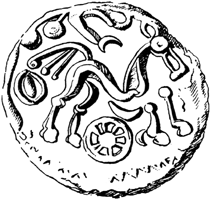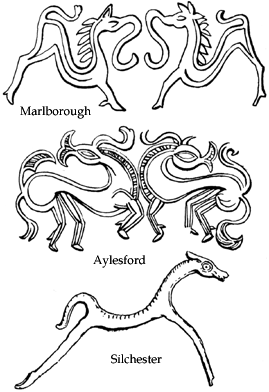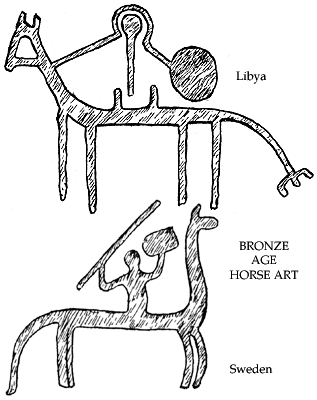
RBH Home
Maps & Travels
Articles
Legends
Towns & Villages
Castles & Houses
Churches
Biographies
Gentry
Family History
Odds & Ends
Mail David
The Uffington White Horse
Part 4: Dating the Horse
 Possible Iron Age
Origins
Possible Iron Age
Origins
In the 1740s, William Asplin wrote,
what he thought was, a humorous attack on Francis Wise’s investigations
at the Uffington White Horse. Within it, however, he did make an interesting point
when he noted the similarity between the design of the Uffington beast and
those which appear on the Iron Age coins of many British tribes. Like the
hill-figure the coin horses are shown with ‘beaked mouths,’ bulbous
eyes and flowing linear legs and body. They also often have triple-tails
and stand above a wheel – a solar symbol or, perhaps, just a simple
representation of a chariot. The relationship suggested that the Uffington
horse might itself  be
of an Iron Age date, as so too, it was assumed, was the
adjoining Uffington
Castle. In 1929, O.G.S. Crawford further suggested
that the hill figure was a tribal emblem for people living at the castle.
A Dobunnic coin has been found there, though it is more likely that it
belonged to the tribe of the Atrebates.
be
of an Iron Age date, as so too, it was assumed, was the
adjoining Uffington
Castle. In 1929, O.G.S. Crawford further suggested
that the hill figure was a tribal emblem for people living at the castle.
A Dobunnic coin has been found there, though it is more likely that it
belonged to the tribe of the Atrebates.
In 1931, Stuart Piggot developed the Iron Age theory further by noting additional similarities between the Uffington Horse and the Roman ‘Silchester Horse’ (the handle of a lost drinking vessel) and other stylised horses on Iron Age buckets from Aylesford and Marlborough. He concluded that the Uffington figure was constructed around the 1st century bc; and, by 1967, Ann Ross was suggesting some connection with the Celtic Horse goddesses: Macha, Epona and Rhiannon. In fact, considering the solar wheels on Iron Age horse coins and the wheel and cheese rolling games at the Uffington festivities, it seems most likely that the hill-figure represents the horse of the Celtic Sun-God, Beli. He was seen as the devil by Christian missionaries and was thus defeated by St. Michael or his earthly counterpart, St. George of local tradition. The Christianised scouring festival is, no doubt, a remnant of his worship and Dragon Hill, perhaps, his temple.
During the cleaning of the White Horse after the Second World War, Peter Grimes undertook a small test excavation, at which he discovered that the creature is entrenched in the bedrock of the hill. Recently it was realised that this rendered the hill-figure susceptible to a newly developed archaeological investigation method known as ‘Optical Stimulated Luminescence’ (OSL) or ‘silt-dating’. This allows the measurement of how long ago a buried soil was last exposed to sunlight. So early layers of neglection and overgrowth made the horse an ideal candidate.
 Miles and Palmer re-examined a cut
in the ‘beak’ where they found successive layers of chalk infill, some
a metre longer than the present jaw. A second trench across the body
showed it had once been a metre wider, but never very different from
the present design. The etching angle had, however, changed so the horse
had ‘climbed’ the hill over years to the flatter upper slope. It would
once have been much more visible from a distance. The results of the OSL
examination dated the Uffington White Horse to somewhere between 1400 and
600 bc. It was therefore not constructed in the Iron Age, but in the late
Bronze Age! Morris Marple had suggested a Bronze Age date in 1949 after
comparing the horse with rock carvings in Sweden and Libya, but his ideas
had been largely forgotten. The same technique for drawing a horse,
particularly the single sweeping long curve of tail, seems to have existed
at this period throughout both Europe and North Africa.
Miles and Palmer re-examined a cut
in the ‘beak’ where they found successive layers of chalk infill, some
a metre longer than the present jaw. A second trench across the body
showed it had once been a metre wider, but never very different from
the present design. The etching angle had, however, changed so the horse
had ‘climbed’ the hill over years to the flatter upper slope. It would
once have been much more visible from a distance. The results of the OSL
examination dated the Uffington White Horse to somewhere between 1400 and
600 bc. It was therefore not constructed in the Iron Age, but in the late
Bronze Age! Morris Marple had suggested a Bronze Age date in 1949 after
comparing the horse with rock carvings in Sweden and Libya, but his ideas
had been largely forgotten. The same technique for drawing a horse,
particularly the single sweeping long curve of tail, seems to have existed
at this period throughout both Europe and North Africa.
The late Bronze Age is increasingly recognised as a time of resettlement due to a shrinkage in population and a change in the climate. Perhaps there was over-farming, famine, disease, conflict. Grazing land turned into bog and heath. There was a dramatic change in people’s religious outlook and they stopped building henge monuments after 1200 bc. It was a time for asserting one’s identity as new groupings emerged in society. It was also the period when the horseman first appears in British life, as shown by equine cheek-pieces found at places like Lyn Fawr in Glamorganshire. They were no doubt used both for battle and herding purposes. Ram’s Hill in Uffington was a Bronze Age trading and cattle ranching centre and it now appears that Uffington Castle was built during the same period. The White Horse must have been carved as a great totem to its inhabitants.
Back to: The Uffington White Horse
